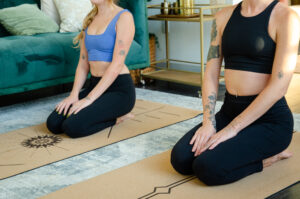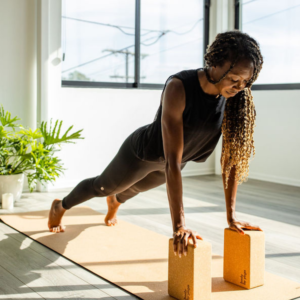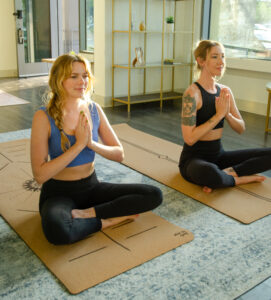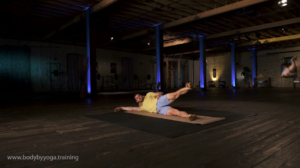10 Minute Yoga for Beginners
- Updated on: July 8, 2022

10 Minute Yoga
Is 10 minutes enough time to spend practicing yoga? Are there yoga classes that are 10 minutes long? Are there benefits to a ten minute yoga class?
When most people talk about their yoga practices, the time spent in their class is usually about an hour long, though this varies. However, it is possible to have a shorter practice and still see results. In fact, starting out with 10 minutes is a great way to begin building your practice and training your body to be able to do more over time.
In addition, for those who do not have much time during the day to be focusing on yoga and/or working out, 10 minute practices allow the ability to still do yoga without taking much time out of the day.
Yoga can be done in the morning, at night, or even on your lunch break. By having a routine that is only 10 minutes long, you are opening up so many more possibilities for when and where to practice.
In this article, we will be learning about the benefits of 10 minute yoga for beginners.
Ready to try out a 10 minute yoga practice? Check out our ten minute Yoga Boost class that focuses on strength for beginners in the video below.
The Benefits of a 10 Minute Yoga Sequence for Beginners
Are there benefits to doing yoga for only 10 minutes? How can a 10 minute class help you?
1. Beginning Your Practice- When you are first starting out with yoga, a long class can feel intimidating. This is why it can be so helpful to have a quick practice. Even just 10 minutes a day can help you to work your way up to longer practices as you build your endurance, increase your flexibility, and strengthen your muscles.
2. Lowering Blood Pressure- Did you know that even 10 minutes of yoga a day can help you to lower your blood pressure? Yoga helps to release stress and anxiety and the breathing techniques that are taught in a class can help to gain control over blood pressure. Any amount of yoga can be very beneficial for blood pressure. One study showed that even a short daily yoga practice succeeded in lowering blood pressure and has antihypertensive results. (Wolf, et al.)
3. Mental Benefits- The deep stretches, mindfulness, meditations, and breathing techniques involved in a yoga practice are great ways to destress the body. Having a few minutes during your day to unwind, center, and refocus can be very helpful in relaxing and releasing tension from the body. This results in the reduction of stress, depression, anxiety, and so much more.
4. Better Focus- In addition, yoga can actually help to increase focus and concentration, making it a great practice for busy work days, or even in school settings. Many schools have actually started to integrate yoga into their curriculum. When it comes to kids, a 10 minute session is actually a great length of time since it can be harder to focus for long periods. One study even integrated 10 minutes of yoga a day into the classroom routine. After eight weeks, results showed a significant improvement in focus and behavior. Sellen, P. (2018) Another study also examined 10 minutes of yoga a day with young children, and results showed better emotional regulation and much more concentration during the day. (Jeppson, 2021)

Is 10 Minutes Enough Time to See the Benefits of Yoga?
So, is 10 minutes actually enough time for yoga? Should you be practicing for longer to see results?
Habit Building- The truth is that 10 minutes of yoga a day can help to build habits as you get used to your new routine. Jumping right into longer practices can be intimidating for some people, so doing just 10 minutes can be a great way to begin doing yoga without feeling overwhelmed.
Results- However, although 10 minutes of yoga a day can have many benefits, it is important to understand that for real results, a longer practice might be necessary. If you are trying to build a new routine, 10 minutes can be a great amount of time to get your body used to the unique yoga movements. If you are looking for faster results, then at least twenty minutes is a recommended length of practice.
So, keep in mind that 10 minutes of practice can build habits. Twenty minutes or more can help you to see better results.
How Long Should a Yoga Practice Be?
With that in mind, how long should a yoga practice generally be? Is there a specific length that is better than others?
As we now know, at least twenty minutes of a practice is better for results, but how long is a typical yoga class?
Most practices will be about an hour long. Some might be shorter (around thirty to forty-five minutes) and others might be longer (around ninety minutes or more) but this truly depends on the class. On average, a class will typically be sixty minutes.
Does this mean that sixty minutes is the prefered length of a class?
The truth is that the necessary amount of time spent practicing yoga will vary person to person. There are different things to take into consideration that might change the right amount of time that you should be doing yoga.
Are you Building a New Routine?- If you have other exercises in addition to yoga, or if you are just trying to get started with your yoga practice, shorter classes can be a good option. Just throwing in 10 minutes of yoga a day can help to build routines.
Is Yoga Your Main Source of Exercise?- If yoga is your only exercise, you might want to try for longer practices more often. If you are only practicing about once or twice a week, longer practices are better to allow for more time to actually practice yoga.
How Much Time Do You Have to Practice?- Another thing to take into consideration is how much time you actually have in your day (or week) to practice yoga. If you are crunched for time and the idea of fitting in a yoga class or other exercise sounds stressful, then just squeezing 10 minutes into your day can be a good idea. If you have more time and want to try for a longer practice, then you can do so. The best part is that there are so many classes and routines to pick from online, so if you have 10 minutes available, you can find a practice for you. If you have a bit more time and can add in a twenty or thirty minute practice, even better. The more you practice, the better, but that does not mean you have to do super long classes each time.
The right amount of time to practice truly depends on each individual person, what they are looking for, and how much available time that they have in their day. That being said, it is good to do at least twenty to thirty minutes for the best results, or even longer if possible. If you can handle a longer class, and you enjoy it, then definitely go for it! If you do not want to have to do a long class but can fit in at least twenty minutes, this is preferable.

How Long Should You Hold Each Pose in Yoga?
How long should you actually hold each yoga pose for? Is there a specific length of time that is necessary for each pose? Do the benefits of the poses change depending on the amount of time that you hold them?
The answer to these questions will depend on the specific yoga class and how much time you have as well as how many poses you are squeezing into that amount of time. Holding poses for longer allows you to experience their benefits more, but if you only have a short amount of time, you might have to shorten the length that you hold them.
Three to Five Breaths- For a 10 minute class, it is good to hold a pose for about three to five deep breaths. This gives you just enough time to experience each pose without using up all of your class time on the first free poses. Start with three breaths, and if you find you can hold it for longer and have time to do so, you can work your way up to five breaths. Shorter hold times are good for shorter classes, warming up, and increasing energy.
Eight to Ten- If you have more time, holding a pose for about eight to 10 breaths is a great option. If each breath is about six seconds long, then 10 breaths will add up to a minute. The longer each breath is, the longer you will wind up holding the pose. The longer you hold a pose, the more of a workout the practice becomes. Long hold times allow for more muscle and endurance building. It can also help to enhance one’s balance, mobility, and mindfulness.
Benefits of Yoga to Beginners
We have learned about the benefits that a 10 minute yoga class can offer for beginners, but overall, what are the benefits of yoga routines for those who are just starting out?
Strength- Yoga is a great way to build up your muscles, especially when it comes to beginners. If you are brand new to yoga and do not have a lot of experience with the poses, you will quickly notice just how much you are actually using your muscles and strengthening your body. If you are not doing any other types of exercise in addition to yoga, then your practice can help you to begin strengthening your muscles. Not only will this help with future yoga practices, but this can actually enhance other possible workouts as well by keeping your muscles in shape and up to the task.
Flexibility- Yoga can be so helpful for flexibility. When you first begin a yoga practice, you might not feel very flexible. This is actually pretty common. The less you are up and moving, the less flexible you will be. This is because our muscles, ligaments, tendons, and fascia become tighter the less they are used. The fascia, or connective tissue of the body, can easily become tight and harden if it is not constantly being used. However, the repetition and practices of specific poses will continue to increase your flexibility over time. Just like endurance, you have to build your way up to having better flexibility. Yoga is about connection, and through practicing, you can learn more about your current level of flexibility while working to increase it as time goes on.
Balance and Stability- Yoga can increase balance and stability through repeated practices of balancing poses. As we age, our balance decreases over time. If you are not doing the necessary practices to keep your balance in good shape, you might find that falling becomes easier. When you are new to yoga, if you are not practicing balance techniques, it is more likely that you may not have the most stability when you first start out. There are specific muscles in the legs and feet that are used when balancing, and sometimes, we have to build those up just like any other muscles. We also use our eyes and our inner ears for balance, and the more that we practice, the more we can learn how to properly use these parts of our bodies to enhance our stability. So, even if you find that you have trouble balancing when you first start, the more you practice yoga, the better your balance will become.
Sleep- Due to the fact that yoga is great for relaxation and stress relief, it can also help your sleep habits. Yoga can help you to fall asleep faster, stay asleep, and even sleep better. If you suffer from insomnia, trying some yoga may be very beneficial for you! You also might try doing some gentle yoga right before bed to help stretch out the body, relax, and unwind.
Energy- Yoga is a great way to stay energized. If you do not have proper time to move around during the day, and spend most of the time sitting, you will most likely find that you do not have as much energy as you would like. Practicing yoga for even just 10 minutes a day can increase your energy levels, building up your endurance, and keeping you feeling more awake and aware. If you often wake up in the morning feeling extremely tired, a great way to start your day and get your blood pumping would be to have a quick yoga practice before getting ready.
Mental Health- Yoga has many mental health benefits. From decreasing stress, depression, and anxiety, and increasing focus and concentration, yoga is great for one’s mental health. Practices of mindfulness, meditation, and breathing exercises promote positive well being, enhancing one’s emotional state.
Cardiorespiratory Health- As you now know, yoga can help decrease blood pressure. In addition, yoga can strengthen the muscles of the lungs and diaphragm through practices of deep breathing. One study had a group of fifty-eight adults practice yoga for an hour a day. This new routine went on for over two years. When compared with a control group, results showed that the yoga group had a much higher aerobic performance, lower BMI, lower resting heart rate and blood pressure, and so much more. The study showed that yoga was better for certain cardiorespiratory benefits than many other recommended aerobic activities. (Sovová, et al.)

How Often Should You Practice Yoga for Best Results?
How often should you be practicing yoga? This answer varies depending on the person and the length of time of the practice. If each class is an hour, then practicing once or twice a week is just fine.
However, when it comes to 10 minute classes, the more often you practice, the better. If you are able to, having a daily 10 minute practice is great. This ensures that you are able to really build a new routine and receive the benefits that your 10 minute class has to offer. If this just is not feasible for you, try to at least practice about four to five times a week to get as much yoga in as possible.
In addition, it is important to take into account whether or not you are doing other exercises as well. If yoga is just one of the many exercises you do, then you will not have to practice it quite as often. However, if yoga is your only exercise, and you are only doing 10 minutes of it at a time, try to aim for at least five to six times a week, if not daily, to ensure that you are getting the best possible results!
How Long are Body By Yoga’s classes?
Our Body By Yoga classes vary in length of time. However, we believe that a yoga class should not have to be sixty minutes.
Therefore, we aim to have our practices be about thirty minutes or less. Many of our classes are closer to twenty or twenty-five minutes, but some will be even shorter, and a few will be longer. Our Yoga Max 33 program, for example, has each practice at thirty-three minutes or less.
If you are looking for just a few minutes of yoga, we have plenty of quick classes and tutorials on our youtube. We also have a few longer practices as well for you to look at. Click here to check out our youtube page.
Best Body by Yoga Programs That are 10 Minutes Long:
Are you ready to begin your yoga practice? Are you looking for 10 minute practices to get you started? We offer a variety of 10 minute practices for you to check out.
If you suffer from chronic back pain, or are just looking to correct your posture, our Better Back Yoga program offers a 10 minute Yoga for Back Pain Relief class. You can check out this practice for free here!
If you are looking for a quick yoga workout to build strength, we recommend looking at our Yoga Sprint class from our Yoga Max 33 program. You can check out our Yoga Sprint class here for free!
If you are looking for a good yoga practice for first thing in the morning, we recommend looking at Yoga Rise part 3, Ready Set, Go from our Yoga Charge program. This is the third video in the Yoga Charge series and is a great way to build habits for practicing yoga in the morning. You can learn more about this program by clicking here.
References: Jeppson, T. (2021, July). The effects of mindful yoga instruction on participants' academic stamina and self-regulation in a kindergarten classroom. OpenRiver. Retrieved October 11, 2021, from https://openriver.winona.edu/educationmasterspapers/2/. Sellen, P. (2018). Yoga and Its Influence on Children's Behavior. The Eleanor Mann School of Nursing Undergraduate Honors Theses Retrieved from https://scholarworks.uark.edu/nursuht/63 Sovová, E., Čajka, V., Pastucha, D., Malinčíková, J., Radová, L., & Sovová, M. (2015). Positive effect of yoga on cardiorespiratory fitness: A pilot study. International journal of yoga, 8(2), 134–138. https://doi.org/10.4103/0973-6131.158482 Wolff, M., Sundquist, K., Larsson Lonn, S., & Midlov, P. (2013, December 7). Impact of yoga on blood pressure and quality of life in patients with hypertension – a controlled trial in primary care, matched for systolic blood pressure. BMC Cardiovascular Disorders. Retrieved October 11, 2021, from https://link.springer.com/article/10.1186/1471-2261-13-111#citeas.
Recent Posts
Categories
Related Articles

Breathing technique to improve your yoga practice

Benefits of yoga before bed

Taking the next step to more challenging yoga

Hatha vs Power yoga
Related Articles

Stretching and Strengthening your hips
In this workout we start slow to warm up your hips. Utilizing low impact workouts like this can be important for beginners and yoga veterans

Hatha vs Power yoga
We’ve created our own unique style of slow burn power yoga that combines Hatha yoga, power yoga, bodyweight exercises and physical therapy. This way in

The importance of maintaining correct alignment
Everything in your body is connected, so when one muscle isnt aligned properly it can be a slippery slope to injury. Building a solid foundation



